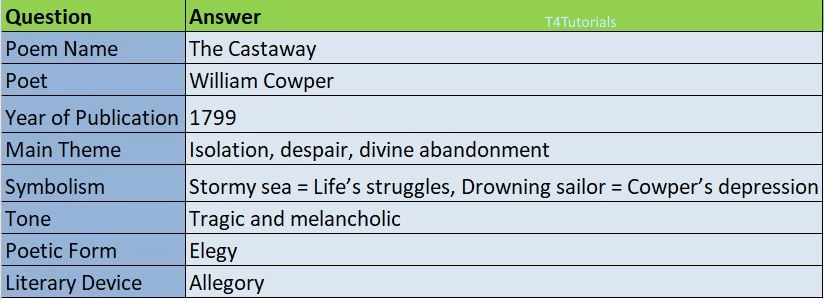Summary:
“The Castaway” is a deeply melancholic poem written by William Cowper in 1799, shortly before his death. The poem is inspired by an incident from George Anson’s sea voyage, where a sailor was washed overboard and left to drown.
- The poem symbolizes Cowper’s own struggles with depression and despair, drawing a parallel between the drowning sailor and his own feelings of abandonment and isolation.
- The stormy sea represents the challenges and hardships of life, while the sailor’s helpless struggle reflects Cowper’s personal sense of being forsaken by God.
- The final stanza expresses hopelessness, as the speaker suggests that he too is lost, just like the sailor, but in a figurative sense—drowning in sorrow.
- The poem is written in elegiac verse, emphasizing its tragic and sorrowful tone.
MCQs:
- Who wrote The Castaway?
A) William Blake
B) William Wordsworth
C) William Cowper
D) John Keats
Answer: C) William Cowper - What inspired Cowper to write this poem?
A) A personal tragedy
B) A biblical story
C) An incident from George Anson’s voyage
D) A Greek myth
Answer: C) An incident from George Anson’s voyage - What does the drowning sailor symbolize?
A) The inevitability of fate
B) Cowper’s personal suffering and sense of abandonment
C) The beauty of nature
D) The power of human resilience
Answer: B) Cowper’s personal suffering and sense of abandonment - Which theme is most prominent in The Castaway?
A) Joy and celebration
B) Religious faith and salvation
C) Isolation and despair
D) War and heroism
Answer: C) Isolation and despair - What does the stormy sea symbolize in the poem?
A) The beauty of nature
B) The unpredictability of life
C) God’s mercy and love
D) The chaos and struggles of life
Answer: D) The chaos and struggles of life - What is the tone of The Castaway?
A) Hopeful and inspiring
B) Tragic and melancholic
C) Satirical and humorous
D) Romantic and passionate
Answer: B) Tragic and melancholic - What literary device is commonly used in the poem?
A) Personification
B) Satire
C) Hyperbole
D) Allegory
Answer: D) Allegory - Why does Cowper compare himself to the lost sailor?
A) He sees himself as a victim of fate and divine abandonment
B) He admires the sailor’s bravery
C) He feels like a hero in his own struggles
D) He believes in a happy ending for both of them
Answer: A) He sees himself as a victim of fate and divine abandonment - How does the poem end?
A) With a hopeful message about survival
B) With the sailor being rescued
C) With a feeling of despair and inevitable doom
D) With a prayer for salvation
Answer: C) With a feeling of despair and inevitable doom - What is the poetic form of The Castaway?
A) Sonnet
B) Elegy
C) Free verse
D) Haiku
Answer: B) Elegy
| Question | Answer |
| Poem Name | The Castaway |
| Poet | William Cowper |
| Year of Publication | 1799 |
| Main Theme | Isolation, despair, divine abandonment |
| Symbolism | Stormy sea = Life’s struggles, Drowning sailor = Cowper’s depression |
| Tone | Tragic and melancholic |
| Poetic Form | Elegy |
| Literary Device | Allegory |
